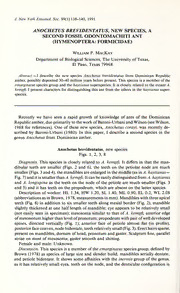
Anochetus Brevidentatus, New Species, a Second Fossil Odontomachiti Ant (Hymenoptera: Formicidae) PDF
Preview Anochetus Brevidentatus, New Species, a Second Fossil Odontomachiti Ant (Hymenoptera: Formicidae)
J. New York Entomol. Soc. 99(1):138—140, 1991 ANOCHETUS BREVIDENTATUS NEW SPECIES, A , SECOND FOSSIL ODONTOMACHITI ANT (HYMENOPTERA: FORMICIDAE) William P. MacKay Department of Biological Sciences, The University of Texas, El Paso, Texas 79968 — Abstract. I describe the new species Anochetus brevidentatus from Dominican Republic amber, possibly deposited 30-40 million years before present. This species is a member ofthe emarginatus species group and the haytianus superspecies. It is closely related to the extant A. kempfi. I present characters for distinguishing this ant from the others in the haytianus super- species. Recently we have seen a rapid growth of knowledge of ants of the Dominican Republic amber, due primarily to the work ofBaroni-Urbani and Wilson (see Wilson, 1988 for references). One of these new species, Anochetus corayi, was recently de- scribed by Baroni-Urbani (1980). In this paper, I describe a second species in the genus Anochetus from Dominican amber. Anochetus brevidentatus, new species Figs. 1, 2, 3, 8 Diagnosis. This species is closely related to A. kempfi. It differs in that the man- dibular teeth are smaller (Figs. 2 and 6), the teeth on the petiolar node are much smaller (Figs. 3 and 4), the mandibles are enlarged in the middle (as in A. haytianus— Fig. 7) and it is smallerthanA. kempfi. It can be easily distinguished fromA. haytianus and A. longispina as the teeth on the node of the petiole are much smaller (Figs. 3 and 5) and it has teeth on the propodeum, which are absent on the latter species. Description of worker: HL 1.34, HW 1.20, SL 1.40, ML 0.90, EL 0.2, WL 2.08 (abbreviations as in Brown, 1978, measurements in mm). Mandibles with three apical teeth (Fig. 8) in addition to six smaller teeth along mesial border (Fig. 2), mandible slightly thickened at one half length of mandible; eye appears to be relatively small (not easily seen in specimen); mesosoma similar to that ofA. kempfi, anterior edge ofmesonotum higherthan level ofpronotum; propodeum with pair ofwell developed spines, directed vertically (Fig. 1); anterior face of petiole almost flat (in profile), posteriorfaceconvex, nodebidentate, teethrelatively small (Fig. 3). Erecthairs sparse, present on mandibles, dorsum ofhead, pronotum and gaster. Sculpture fine, parallel striae on most of mesosoma; gaster smooth and shining. Female and male: Unknown. Discussion. This species is a member ofthe emarginatus species group, defined by Brown (1978) as species of large size and slender build, mandibles serially dentate, and petiole bidentate. It shows some affinities with the inermis group of the genus, as it has relatively small eyes, teeth on the node, and the denticular configeration is 1991 NEW FOSSIL ANOCHETUS 139 Figs. 1-8. Anochetus spp. workers. 1. A. brevidentatus, mesosoma and petiole. 2. A. brevi- dentatus, full face view ofhead. 3. A. brevidentatus, anteriorface ofpetiole. 4. A. kempfi, anterior face of petiole. 5. A. haytianus, anterior face of petiole. 6. A. kempfi, right mandible. 7. A. haytianus, right mandible. 8. A. brevidentatus, apical mandibular teeth (from below). (Scale: Figs. 1-7 line equals 1 mm, Fig. 8 line equals 0.25 mm.) similar to species in this group. The mesonotal outline is also similar to species in the inermis group. It is smaller than other species in the emarginatus group and could be identified as a member of the inermis group using Brown’s key (1978). It is a member of the haytianus superspecies, defined as those species with six-nine teeth and denticles on the medial border ofthe mandible. This superspecies is found only in the West Indies, and includes A. haytianus, A. kempfi, A. longispina and A. brev- JOURNAL OF THE NEW YORK ENTOMOLOGICAL SOCIETY 140 Vol. 99(1) identatus. The emarginatus and mayri species groups (to which the fossil species A. corayi belongs) are both represented in the recent fauna of Hispaniola. Type series. Single holotype worker from the DOMINICAN REPUBLIC, La Toca Mine near Las Aguitas, imbedded in amber, which I purchased from Amberica S. A., Calle Z, No. 5 (NACO), P.O. Box 429-2, Santo Domingo, Dominican Republic. It is deposited in the Museum of Comparative Zoology, Harvard. The specimen is well preserved, in a clearbrown amber matrix. The left mandible is somewhat twisted and the right antenna is missing the funiculus. Known only from the holotype. This amber is of the oldest and hardest in the Dominican Republic, and reported to be 30 to 40 million years old (Lambert et al., 1985). The age of this specimen is based on the presumed rate of methyl radical decay and may be questionable. Etymology. From Latin, referring to the short teeth on the petiolarnode, a character which separates it from all others in the superspecies haytianus. ACKNOWLEDGMENTS Dr. David Smith ofthe Systematic Entomological Laboratory, Agricultural Research Service, Washington, D.C., loaned specimens of A. kempfi and A. haytianus. John Lattke and two anonymousreviewerscriticallyreviewedthemanuscript. Thetwo reviewersprovidedimportant information regarding the presumed age ofthe specimen. LITERATURE CITED Baroni-Urbani, C. 1980. Anochetus corayi n. sp., the first fossil Odontomachiti ant (amber collection Stuttgart: Hymenoptera, Formicidae. II: Odontomachiti). Stuttgarter Beitrage zur Naturkunde 55:1-6. Brown, W. L. 1978. Contributions toward a reclassification ofthe Formicidae. VI. Ponerinae, tribe Ponerini, subtribe Odontomachiti. Section B. Genus Anochetus and bibliography. Studia Entomologica 20:549-638 + 12 plates. Lambert, J. B., J. S. Frye and G. O. Poinar. 1985. Amber from the Dominican Republic: analysis by nuclear magnetic resonance spectroscopy. Archaeometry 27:43-51. Wilson, E. O. 1988. The biogeography ofthe West Indian ants (Hymenoptera: Formicidae). In: J. K. Liebherr (ed.), Zoogeography ofCaribbean Insects. Comstock Publishing Co., Cornell Univ. Press, Ithaca, NY, pp. 214-230. Received October 1989; accepted 9 July 1990. 1 1
